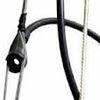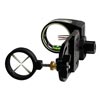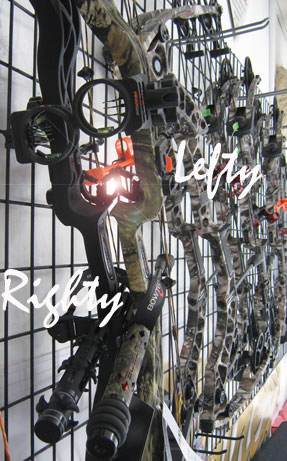There’s a lot of peep sight choice out there and they are all designed to help align your dominant eye with your sight pin guard/sight ring. It really is a bit of archery kit worth getting set up right because it will give you a more consistent anchor point. And that means consistent shot placement as it forces your head to be in the same spot, shot after shot. There’s three types of peep sights …

Self-aligning Peeps – Rubber Tube Peeps are very effective and are well suited to most bows. Self-aligning peeps rob you a little arrow speed, but they do keep the peep sight perfectly aligned all the time. Their main downfall is the rubber tube will inevitably perish or snag off the peep peg. So carry some spare peep tubing in your daypack?

Double slots Peeps – Double slots Peeps work beautifully… but only with high quality, well shot in bowstrings. Many experienced archer types prefer double slot peeps. You’ll recognise them as those you’ll always see “training” (twisting) their bowstring as they wait for their turn on the field course. The training trick helps keep double slots in alignment at full draw.

Triple Slot Peeps – If double slot peeps sound too fussy, go for the Triple (trio style) String Peep. Triples split the bowstring strands into thirds, not halves like the double slots. So even if your bowstring rotates slightly, a trio will still give you a clear view. Even the best bowstrings will twist or creep as seasons change. Fly from an Aussie summer and hunt in a US winter and see what happens to your peep on your beloved rock solid bowstring! Some personality types can’t ignore the 3rd strand ‘ghosting’ effect a triple slot peep will give them though their line of sight. They then can choose the double slot peep and let string creep give them their migraine that way. I have a theory about peep sight fussiness – it goes like this – YOU’RE NOT AIMING PROPERLY! You should be so focused on aiming, that a ladybug could do handstands on your peep and you’d never know. Of course this can never be tested properly because not all ladybugs do handstands (and those that do don’t survive the release.)

Rear Sights – Rear Sights eliminate the need for a peep altogether. Low light performance is better than you get from a peep sight. But if it’s too dark too see your pins through your peep sight, maybe, me thinks, it’s too dark too hunt ethically? Because rear sights are mounted to the bowsight base or the bow riser, bow torque and sight alignment are pretty much eliminated – which is a good thing – because you’ll be more consistent. You certainly won’t have peep alignment problems with a rear sight. Some exceptional quality (and expensive) hunting sights made by the likes of Surelok etc incorporate this innovation in their sight pin guards. They have a ‘dot’ that can be adjusted to centre in a bubble that will only appear ‘centred’ when you repeat your anchor perfectly. These sights also have gravity adjustment for those who like to shoot their bows on a slight cant too. I know, I got off topic, but if you’re thinking “when/where will or please make it end?”, you can always go Ted Nugent and not bother with a sight at all. By any measure, he’s done quite well over the years without a bow sight…
Want to Install a Peep? You’ll need a bow press or a string separator to open up the bow string strands. In the workshop, most often we install peeps at 5 1/2in above the nocking point. For taller archers, we use larger diameter peeps and install them higher. Shorter archers most often suit medium sized peeps at a 5in height. Peeps then need to be served in place. At full draw, check that the sight pin guard matches the peep hole – it should disappear or ghost from view. If you have to, move your sight base in or out until you achieve this and you’re good to go.



